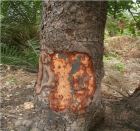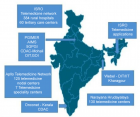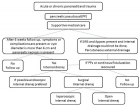Abstract
Research Article
Effect of Khaya Senegalensis Bark and Oil on Post-Harvest Fungal Agents of Groundnut Seeds Rot in Adamawa State, Nigeria
Channya FK*, Asama P and Anjili SM
Published: 02 August, 2019 | Volume 3 - Issue 2 | Pages: 076-080
Standardized method of seed treatment is of prime importance in the production of groundnut. The study was to carry out control trial using bark extract (aqueous and ethanol) and oil (seed) of mahogany (Khaya senegalensis) on seven (7) isolated fungi from two groundnut varieties (peruvian and valencia). The result shows that both mahogany bark and seed extracts are capable of inhibiting mycelial growth of all the isolates. There was no significant variation between the aqueous and ethanol bark extracts in-vitro, however the in-vivo test shows a significant difference between the aqueous and the ethanol bark extract in which the ethanol extract reduced growth of the pathogens more than the aqueous. For all the pathogens except Rhizopus stolonifer there was no growth between 50% to 100% concentration of the Khaya senegalensis oil in-vitro, however in-vivo control at 50% produced scanty to moderate growth for all the pathogens except Rhizopus stolonifer on peruvian, while there was full coverage on the seeds of valencia variety with Aspergillus niger and Rhizopus stolonifer having total coverage though Pseudaiiescheria boydii and Cylindrocarpon lichenicola were effectively inhibited and showed no growth at the 50% and 100%. Further research to focus on the quantifying the chemical constituents and formulation are suggested.
Read Full Article HTML DOI: 10.29328/journal.jpsp.1001035 Cite this Article Read Full Article PDF
Keywords:
Groundnut; Fungi; Mahogany; Bark; Seed control
References
- Weiss EA. Oilseed Crops. 2nd edition. Blackwell Science Ltd., Oxford, London, BerlinCarlton, Paris. 2000; 31-36.
- Al-Amod MO. Seed-borne fungi of some peanut varieties from Hadhramout and Abyan Governorates in Yemen. International Journal of Agricultural Technology. 2015; 11: 1359-1370.
- Osman RA. Occurrence and Identitication of Seed Borne Fungi Associated with Groundnuts in Kordofan States. A Thesis Submitted in Partial Fulfillment of the Requirements for the M.Sc. Degree in Plant Protection. Sudan University of Science and Technology College of Graduate Studies and Scientific Research University of Zalingei. 2016.
- Elwakil MA, El-Metwally MA. Seed-borne Fungi of Peanut in Egypt; Pathogenicity and Transmission. Pakistan of Biological Science. 2001; 4: 63-68.
- Chavan AM, Kakde RB. Studies on abnormal oilseeds mycoflora from Marathwada region. Bionano Frontier. 2008; 2: 101-104.
- Olusegun A, Hussaini AM, Isaac MO, Mojisola E, Kingsley OI, et al. Fungal and Mycotoxin Contamination of Nigerian Foods and Feeds: in Mycotoxin and Food Safety in Developing Countries, edited by Hussaini Anthony Makun, ISBN 978-953-51-1096-5. 2013.
- Manimurugan C. Pathogen Free Seed Production in Black Gram (Vigna mungo (L.) Hepper). M.sc. (Ag.) Thesis, Tamil Nadu Agricultural University, Coimbatore, Tamil Nadu. 2003.
- Ahmad I, Beg A. Antimicrobial phytochemical studies on 45 Indian medicinal plants against multi-drug resistant human pathogens. Journal Ethno. Pharmacy. 2007; 7: 113-123. PubMed: https://www.ncbi.nlm.nih.gov/pubmed/11167029
- Ajobade TA and Amusa A. Evaluation of antifungal efficacy of some plant extract on cusvularia. Lunate the causal organisms of leaf spot. African Journal of Environment sciences and technology. 2001; 4: 1010
- Jennings AA, Li Z. Residential surface soil guidance applied worldwide to the pesticides added to the Stockholm Convention in 2009 and 2011. J. Environmental Manag. 2015; 160: 226-240. PubMed: https://www.ncbi.nlm.nih.gov/pubmed/26144561
- Fantke P, Juraske R, Antón A, Friedrich R, Jolliet O. Dynamic multicrop model to characterize impacts of pesticides in food. Environ. Sci. Technol. 2011; 45: 8842-8849.PubMed: https://www.ncbi.nlm.nih.gov/pubmed/21905656
- Fantke P, Friedrich R, Jolliet O. Health impact and damage cost assessment of pesticides in Europe. Environ. Int. 2012; 49: 9-17.PubMed: https://www.ncbi.nlm.nih.gov/pubmed/22940502
- Odukkathil G, Vasudevan, N. Residues of endosulfan in surface and subsurface agricultural soil and its bioremediation. J. Environ. Manag. 2016; 165: 72-80. PubMed: https://www.ncbi.nlm.nih.gov/pubmed/26413801
- Orton TG, Saby NPA, Arrouays D, Jolivet CC, Villanneau EJ, et al. Spatial distribution of lindane concentration in topsoil across France. Sci. Total Environ. 2013; 443: 338-350. PubMed: https://www.ncbi.nlm.nih.gov/pubmed/23202380
- Li Z, Jennings A. Global variations in pesticide regulations and health risk assessment of maximum concentration levels in drinking water. J Environ Manag. 2018; 212: 384-394.PubMed: https://www.ncbi.nlm.nih.gov/pubmed/29455146
- Ademola IO, Fagbemi BO, Idowu SO. Evaluation of antihelminthic activity of Khaya senegalensis extracts against gastro intestinal nematodes of sheep: in vitro and in vivo studies. Vet. Parasitol. 2004; 122: 151-164. PubMed: https://www.ncbi.nlm.nih.gov/pubmed/15177720
- Abdelgaleil SAM, Iwagawa T, Doe M, Nakatani M. Antifungal limonoids from the fruits of Khaya senegalensis. Fitoterapia. 2004; 75: 566-572. PubMed: https://www.ncbi.nlm.nih.gov/pubmed/15351110
- Abdelgaleil SAM, Okamura H, Iwagawa T, Sato A, Miyihara I, et al. Khayanolides rearranged phragmalin limonoid antifeedants from Khaya senegalensis. Tetrahedron. 2001; 57: 119-126.
- Ijato JY, Otoide JE, Ijadunola JA, Aladejimokun AO. Efficacy of antimicrobial effect of Venonia amygdalina and Tridax procumbens in in vitro control of tomato (Lycopersicum esculentum) post -harvest fruit rot. Report and Opinion. 2011; 3: 120-123.
- Gomez KA, Gomez AA. Statistical Procedure for Agriculi tural Research. 2nd ed. Wiley. 1984; 680.
- Scheff HA. Method of judging all contrast in the Analysis of Variance. Biometric. 1953; 40: 104-107.
- Abdulsalam AA, Zakari BG, Chimbekujwo IB, Channya FK, Bristone B. Isolation and Control of Fungi Associated with Neck Rot Disease of Onions (Allium cepa L.) In Bama, Borno State, Nigeria. Global Journal of Biology, Agriculture and Health Sciences. 2015;4: 35-39.
- Liman IB, Ibrahim S, Rabah NT. The efficacy of Mahogany leaf extract on Root knot nematode disease of tomato (Lycopersicon esculentum. Nigerian Journal of Basic and Applied Sciences. 2010; 18: 272-276.
- Montes BR. Natural Plant Products to Combact Pathogens. Mexican Journal of Phytopathology. 1996; 14: 9-14.
- Khare NP, Lucas B, Seavey KC, Liu YA, Sirohi A, et al. Steady State and Dynamic Modeling of Gas-Phase Polypropylene Processes using Stirred-Bed Reactors. Ind. Eng. Chem. Res. 2004; 43: 884.
- O’Bryne DJ, Knauft DA, Shireman RB. Low fat monounsaturated rich diets containing high-oleate peanuts improve serum lipoprotein profiles. Lipids.1997; 32: 687-695.PubMed: https://www.ncbi.nlm.nih.gov/pubmed/9252956
- Bamaiyi LJ, Ndams IS, Toro WA, Odekina S. Effect of mahogany (Khaya senegalensis) seed oil in control of Callosobruchus maculatus on stored cowpea. Plant Protect. Sci. 2006; 42: 130-134.
Figures:

Figure 1

Figure 2
Similar Articles
-
Advances in research of the structural gene characteristics of the aflatoxin biosynthetic gene clusterZhu-Mei He*,Qi-Zhang Li. Advances in research of the structural gene characteristics of the aflatoxin biosynthetic gene cluster. . 2018 doi: 10.29328/journal.jpsp.1001022; 2: 068-082
-
Causal agents of Post-harvest Rot of Pumpkin (Cucurbita pepo L.) and their control using Indigenous Practices in Hong, Adamawa StateAnjili SM*,Kazi N,Chimbekujwo IB. Causal agents of Post-harvest Rot of Pumpkin (Cucurbita pepo L.) and their control using Indigenous Practices in Hong, Adamawa State. . 2019 doi: 10.29328/journal.jpsp.1001033; 3: 062-066
-
Effect of Khaya Senegalensis Bark and Oil on Post-Harvest Fungal Agents of Groundnut Seeds Rot in Adamawa State, NigeriaChannya FK*,Asama P,Anjili SM . Effect of Khaya Senegalensis Bark and Oil on Post-Harvest Fungal Agents of Groundnut Seeds Rot in Adamawa State, Nigeria. . 2019 doi: 10.29328/journal.jpsp.1001035; 3: 076-080
-
In vitro and preventative field evaluations of potential biological control agents and synthetic fungicides for control of Clarireedia jacksonii sp. nov.Robert A Kerr*,Jeffery W Marvin,Lambert B McCarty,William C Bridges,S Bruce Martin,Christina E Wells. In vitro and preventative field evaluations of potential biological control agents and synthetic fungicides for control of Clarireedia jacksonii sp. nov.. . 2020 doi: 10.29328/journal.jpsp.1001043; 4: 001-008
-
Antiviral and Antinematodal potentials of chitosan: ReviewMahmoud Hamdy Abd El-Aziz*,Mohamed Salah Khalil. Antiviral and Antinematodal potentials of chitosan: Review. . 2020 doi: 10.29328/journal.jpsp.1001051; 4: 055-059
-
Antifungal activity of epecific plant essential oils against fusarium graminearumEmre Yörük*,Esma Özsoy,Buket Kesercan. Antifungal activity of epecific plant essential oils against fusarium graminearum. . 2020 doi: 10.29328/journal.jpsp.1001052; 4: 060-062
-
Pathogen identification and control of sooty spot caused by Cladosporium ramotenellum, appearing on fresh easy peeler mandarins from PerúCelia Murciano*,Benito Orihuel-Iranzo,Jeniffer J Oliver-Chirito. Pathogen identification and control of sooty spot caused by Cladosporium ramotenellum, appearing on fresh easy peeler mandarins from Perú. . 2021 doi: 10.29328/journal.jpsp.1001059; 5: 044-052
-
Strobilurins: New group of fungicidesRasha E Selim*,Mohamed S Khalil. Strobilurins: New group of fungicides. . 2021 doi: 10.29328/journal.jpsp.1001062; 5: 63-064
-
Effect of chitosan and silicon oxide treatments on postharvest Valencia Late (Citrus × sinensis) fruitsBeltrán R*,Otesinova L,Cebrián N,Zornoza C,Breijo F,Reig J,Garmendia A,Merle H. Effect of chitosan and silicon oxide treatments on postharvest Valencia Late (Citrus × sinensis) fruits. . 2021 doi: 10.29328/journal.jpsp.1001063; 5: 065-071
-
Nematicides in EgyptMohamed S Khalil*. Nematicides in Egypt. . 2022 doi: 10.29328/journal.jpsp.1001069; 6: 022-023
Recently Viewed
-
Hypochlorous acid has emerged as a potential alternative to conventional antibiotics due to its broad-spectrum antimicrobial activityMaher M Akl*. Hypochlorous acid has emerged as a potential alternative to conventional antibiotics due to its broad-spectrum antimicrobial activity. Int J Clin Microbiol Biochem Technol. 2023: doi: 10.29328/journal.ijcmbt.1001026; 6: 001-004
-
KYAMOS Software - Mini Review on the Computer-Aided Engineering IndustryAntonis Papadakis*,Sofia Nikolaidou. KYAMOS Software - Mini Review on the Computer-Aided Engineering Industry. Int J Phys Res Appl. 2025: doi: 10.29328/journal.ijpra.1001105; 8: 010-012
-
Ischemic Stroke and Myocarditis Revealing Behçet’s Disease in a Young Adult: Diagnostic Challenges and Therapeutic PerspectivesObeidat Saleh Muhammed*,Abdallani B,Amine Z,Boucetta A,Bouziane M,Haboub M,Habbal R. Ischemic Stroke and Myocarditis Revealing Behçet’s Disease in a Young Adult: Diagnostic Challenges and Therapeutic Perspectives. J Cardiol Cardiovasc Med. 2025: doi: 10.29328/journal.jccm.1001205; 10: 016-021
-
Evolution of the Mineralocorticoid Receptor and Gender Difference in Cardiovascular PathologyAlessandro Zuccalà*. Evolution of the Mineralocorticoid Receptor and Gender Difference in Cardiovascular Pathology. J Cardiol Cardiovasc Med. 2025: doi: 10.29328/journal.jccm.1001204; 10: 008-015
-
Texture of Thin Films of Aluminum Nitride Produced by Magnetron SputteringStrunin Vladimir Ivanovich,Baranova Larisa Vasilievna*,Baisova Bibigul Tulegenovna. Texture of Thin Films of Aluminum Nitride Produced by Magnetron Sputtering. Int J Phys Res Appl. 2025: doi: 10.29328/journal.ijpra.1001106; 8: 013-016
Most Viewed
-
Evaluation of Biostimulants Based on Recovered Protein Hydrolysates from Animal By-products as Plant Growth EnhancersH Pérez-Aguilar*, M Lacruz-Asaro, F Arán-Ais. Evaluation of Biostimulants Based on Recovered Protein Hydrolysates from Animal By-products as Plant Growth Enhancers. J Plant Sci Phytopathol. 2023 doi: 10.29328/journal.jpsp.1001104; 7: 042-047
-
Sinonasal Myxoma Extending into the Orbit in a 4-Year Old: A Case PresentationJulian A Purrinos*, Ramzi Younis. Sinonasal Myxoma Extending into the Orbit in a 4-Year Old: A Case Presentation. Arch Case Rep. 2024 doi: 10.29328/journal.acr.1001099; 8: 075-077
-
Feasibility study of magnetic sensing for detecting single-neuron action potentialsDenis Tonini,Kai Wu,Renata Saha,Jian-Ping Wang*. Feasibility study of magnetic sensing for detecting single-neuron action potentials. Ann Biomed Sci Eng. 2022 doi: 10.29328/journal.abse.1001018; 6: 019-029
-
Pediatric Dysgerminoma: Unveiling a Rare Ovarian TumorFaten Limaiem*, Khalil Saffar, Ahmed Halouani. Pediatric Dysgerminoma: Unveiling a Rare Ovarian Tumor. Arch Case Rep. 2024 doi: 10.29328/journal.acr.1001087; 8: 010-013
-
Physical activity can change the physiological and psychological circumstances during COVID-19 pandemic: A narrative reviewKhashayar Maroufi*. Physical activity can change the physiological and psychological circumstances during COVID-19 pandemic: A narrative review. J Sports Med Ther. 2021 doi: 10.29328/journal.jsmt.1001051; 6: 001-007

HSPI: We're glad you're here. Please click "create a new Query" if you are a new visitor to our website and need further information from us.
If you are already a member of our network and need to keep track of any developments regarding a question you have already submitted, click "take me to my Query."

























































































































































